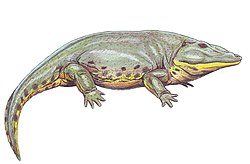Phylogeny
As originally interpreted by Carlson (1987), Perryella shared features with both trimerorhachid dvinosaurs and with dissorophoids based on select comparisons. For example, it shares a medial process of the quadratojugal that participates in the jaw articulation with Micromelerpeton, but this process does not wrap around a dorsal process of the quadrate as in many dissorophoids. A large exposure of the palatine bone on the skull roof (typically only exposed on the palate), termed a 'lateral exposure of the palatine' (LEP) is also common to dissorophoids and is found in Perryella, but it also occurs in some dvinosaurs like Acroplous and Isodectes. Carlson also cited proportions of the orbits, otic notches, and interpterygoid vacuities; the presence of denticles on the parasphenoid; the absence of an intertemporal; the presence of a double occipital condyle; and a retroarticular process on the lower jaw as evidence of dissorophoid affinities, although as he noted, these are commonly shared with other "advanced" temnospondyls and are perhaps better viewed as evidence against dvinosaur affinities. Carlson's reticence to place it within Dissorophoidea stemmed from the anatomy of the otic notch, as well as the separation between the lacrimal and the orbit and an anteriorly extensive jugal. [1] Carlson (1987) originally did not place it within a particular family or superfamily as a result.
Other workers more confidently placed Perryella as a dissorophoid. [4] In 2006, a phylogenetic analysis of Perryella as part of a larger redescription placed it within Dvinosauria as an intermediate form between trimerorhachids and other dvinosaurs. This analysis included stem tetrapods and Paleozoic temnospondyls and recovered dissorophoids and dvinosaurs as sister groups. Below is a portion of their phylogenetic topology:
Schoch & Milner (2014) placed Perryella as an indeterminate dissorophoid, arguing that it shared certain features such as the LEP with 'amphibamids' (now amphibamiforms) and micromelerpetids; this classification was based on qualitative comparisons, as they did not perform a phylogenetic analysis. Schoch (2018) included Perryella in an analysis and recovered it as a "stem dissorophoid" (closely related to Dissorophoidea). Below is Schoch's phylogeny: [5]
This page is based on this
Wikipedia article Text is available under the
CC BY-SA 4.0 license; additional terms may apply.
Images, videos and audio are available under their respective licenses.



